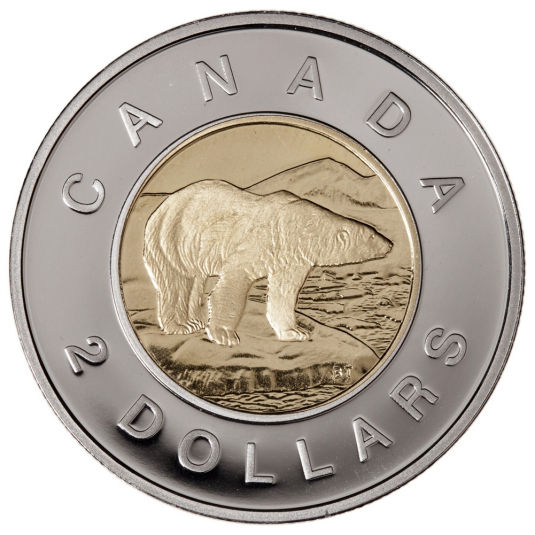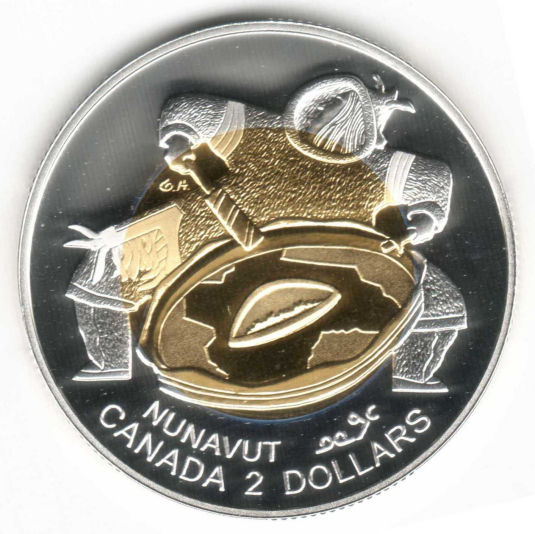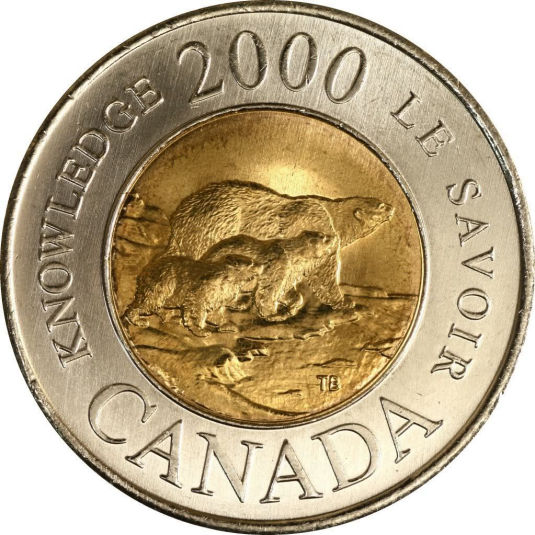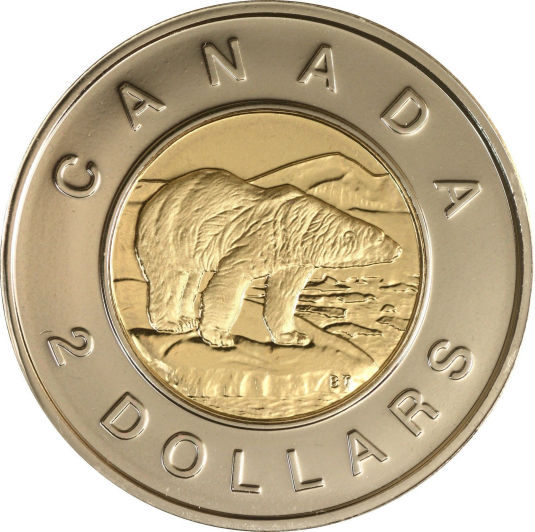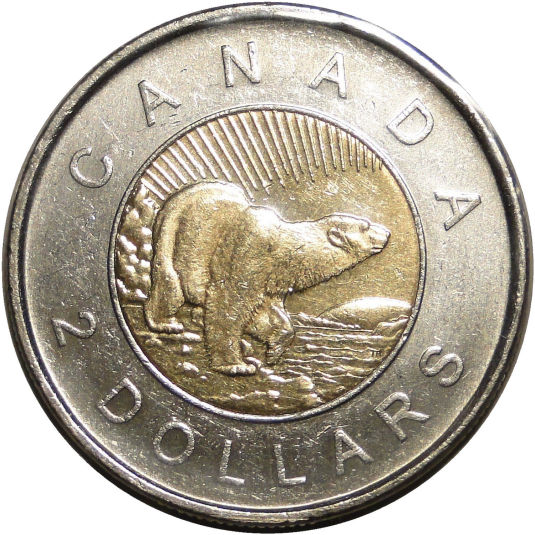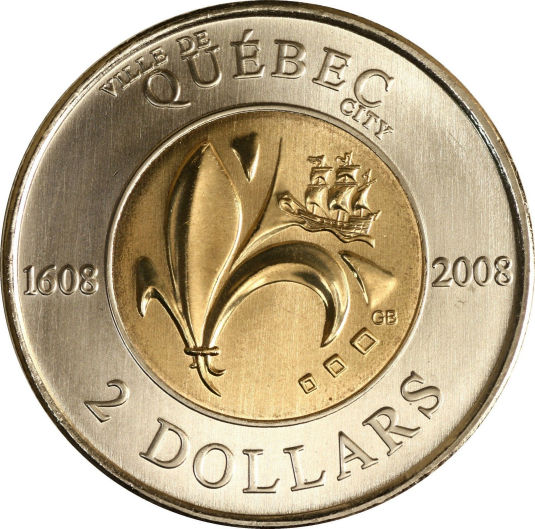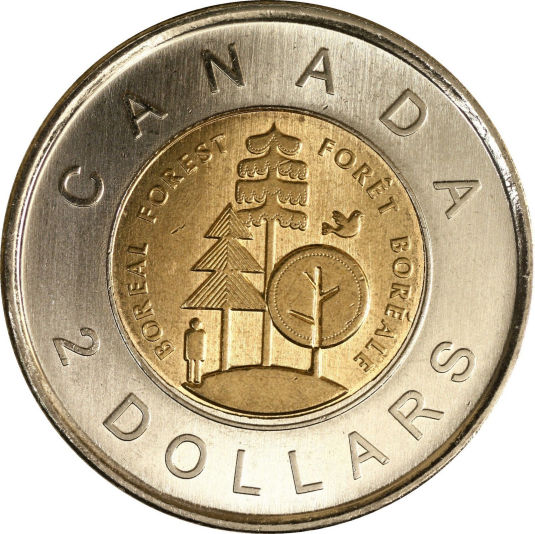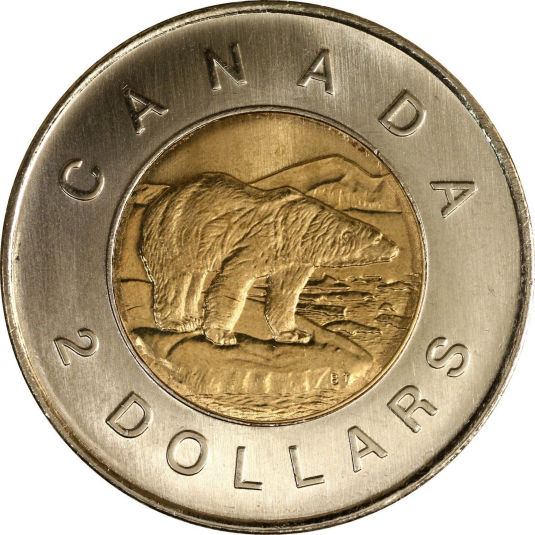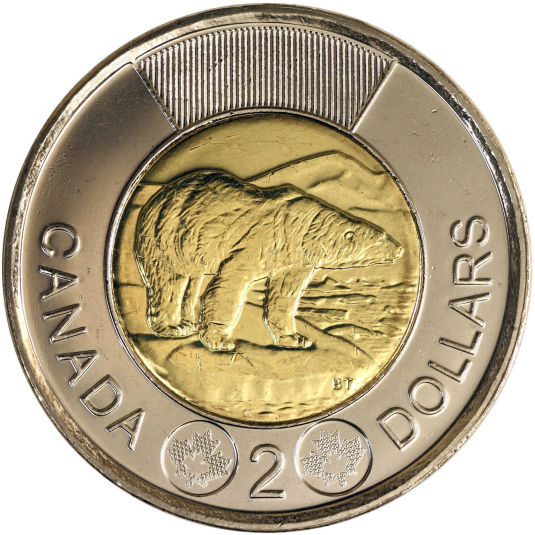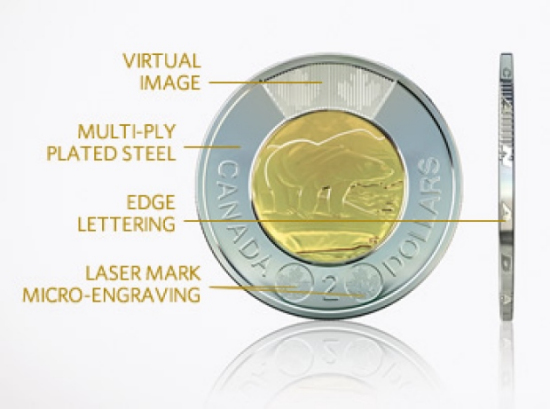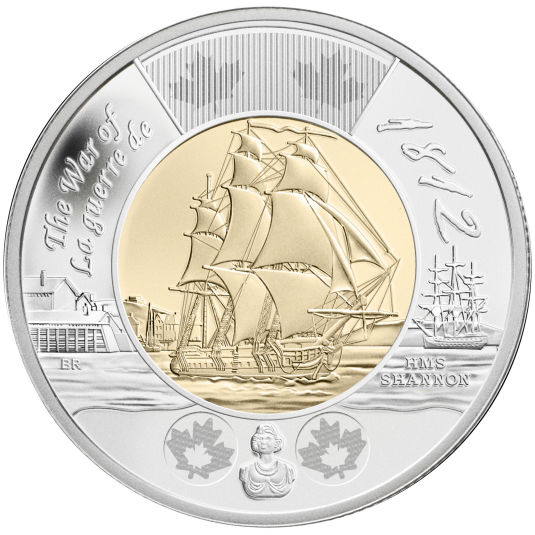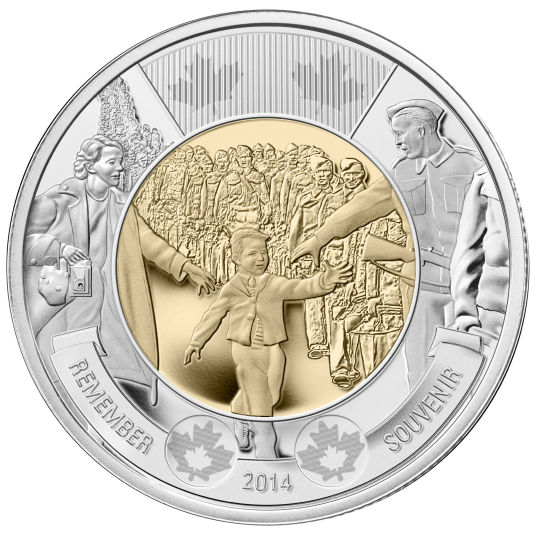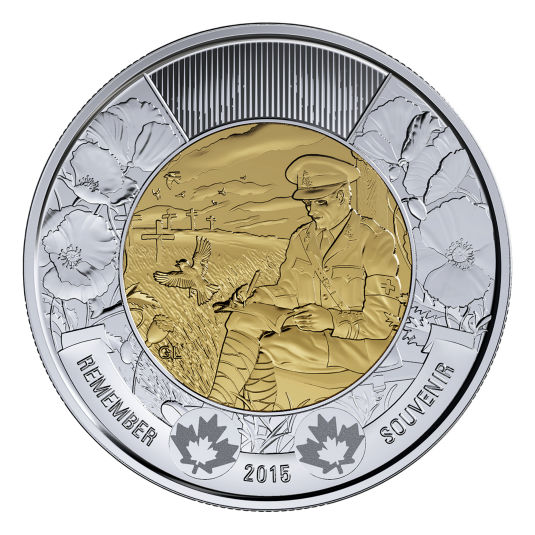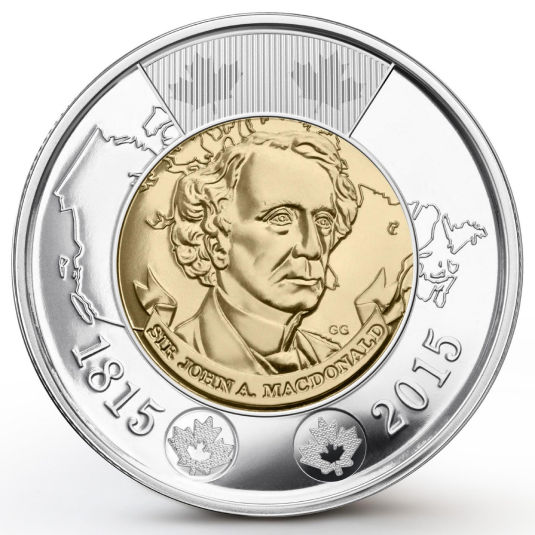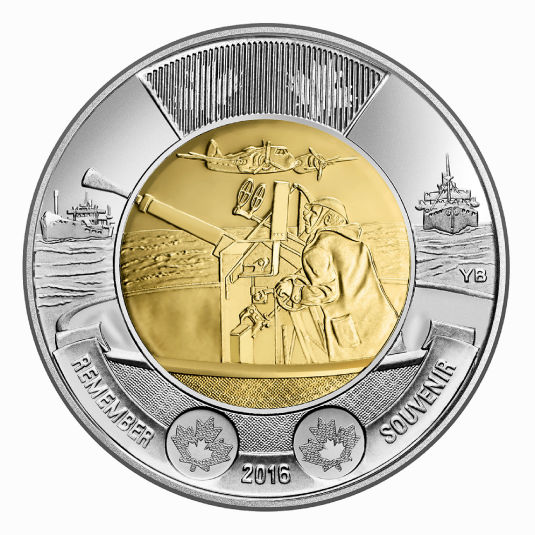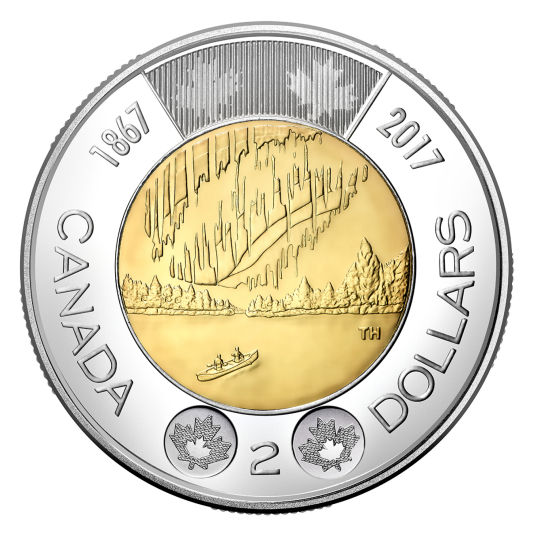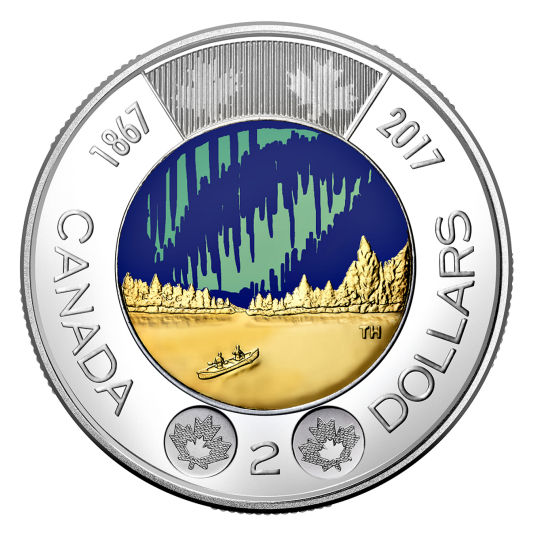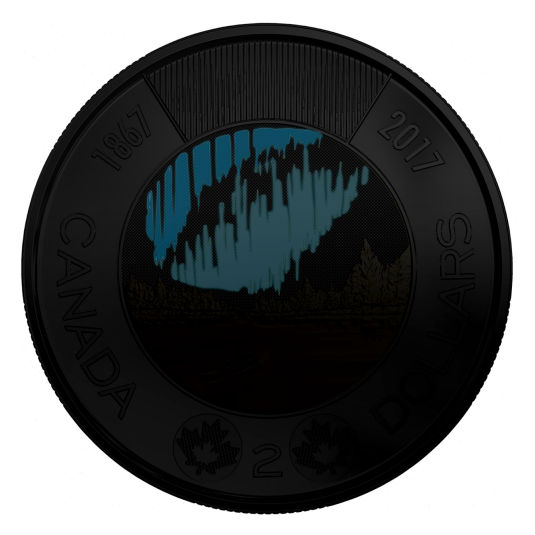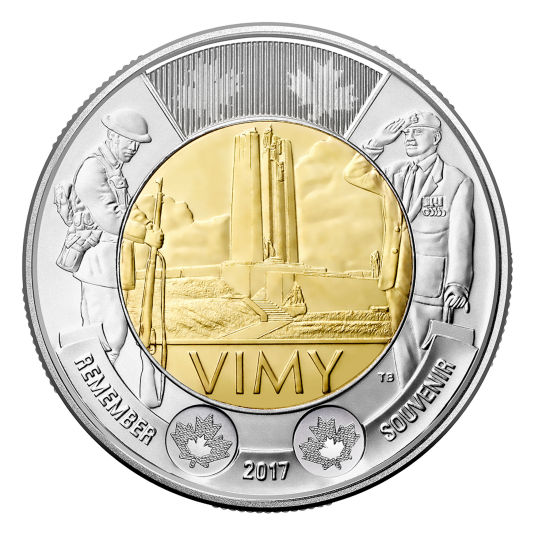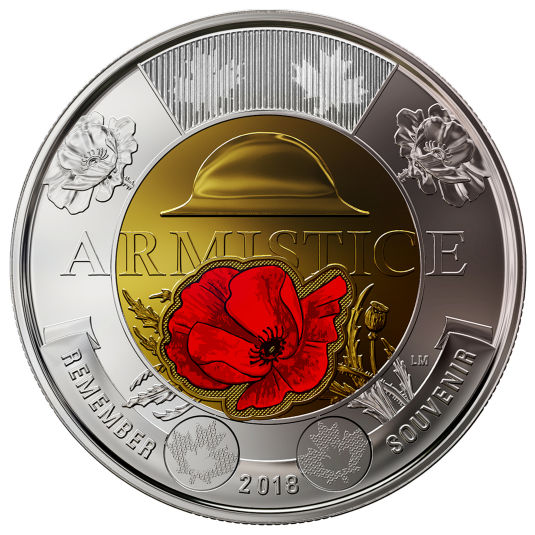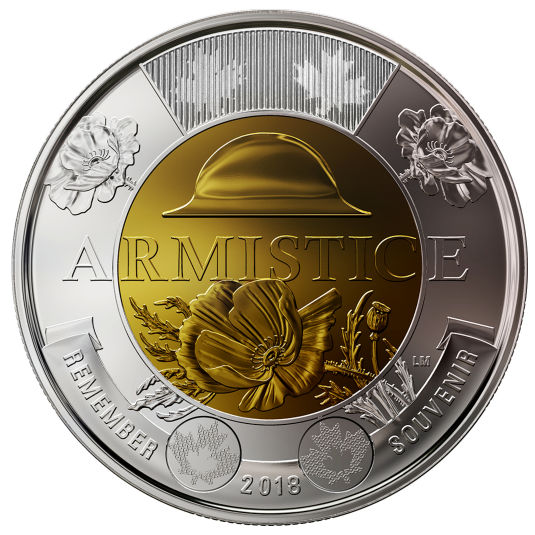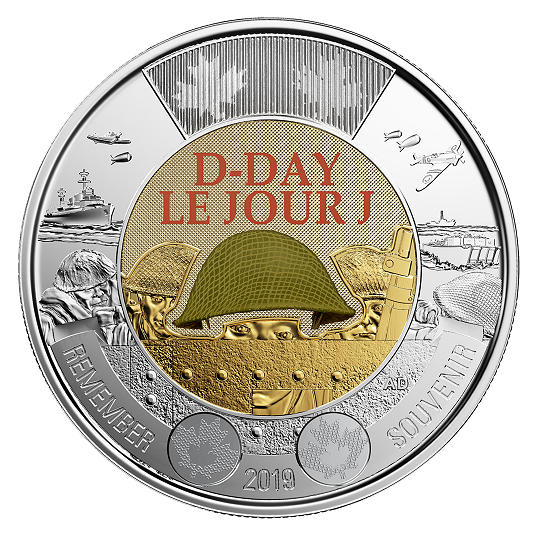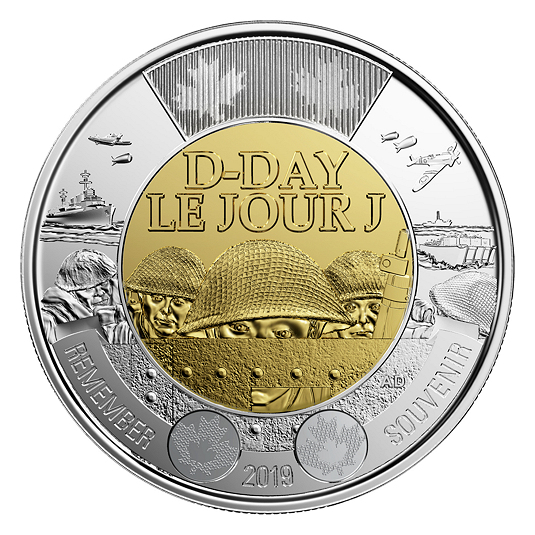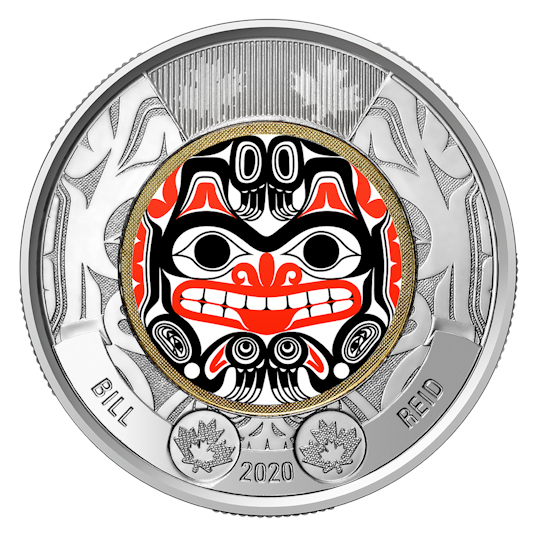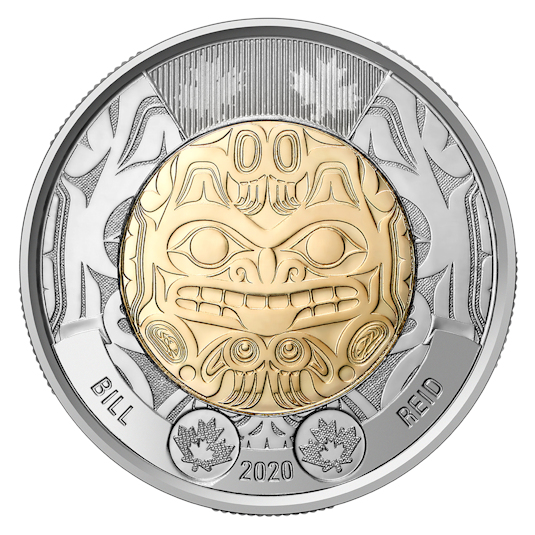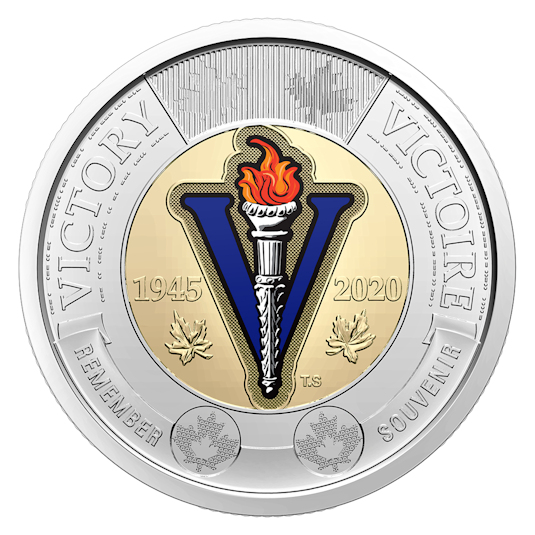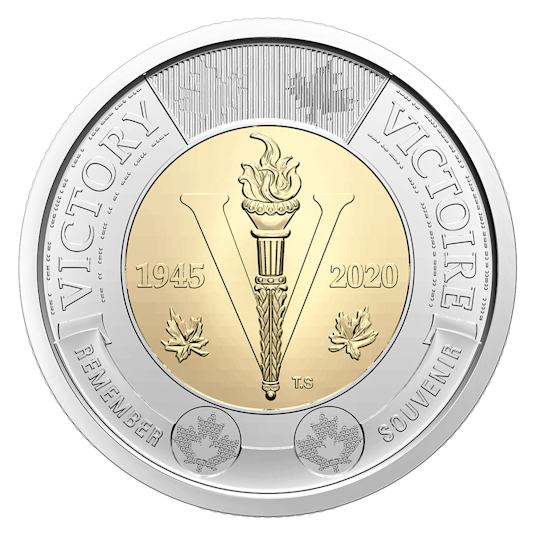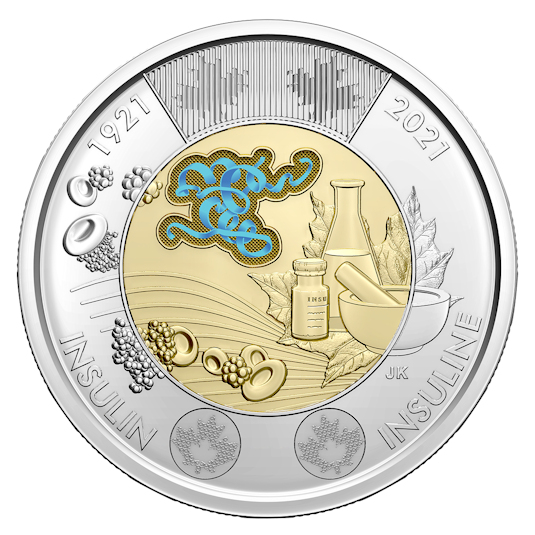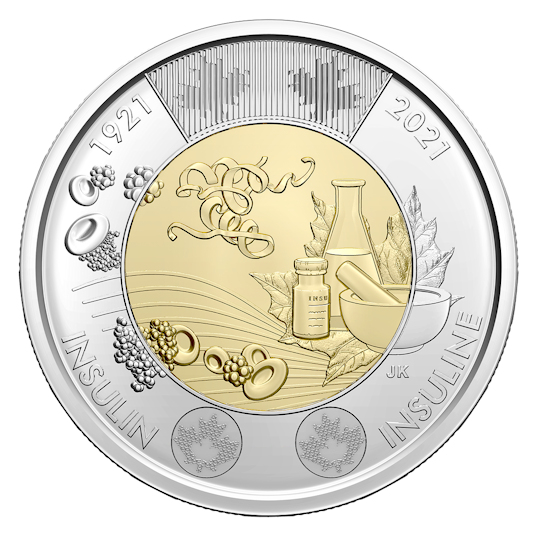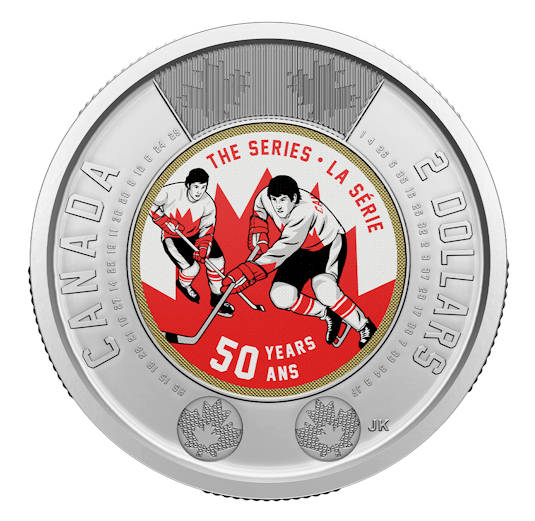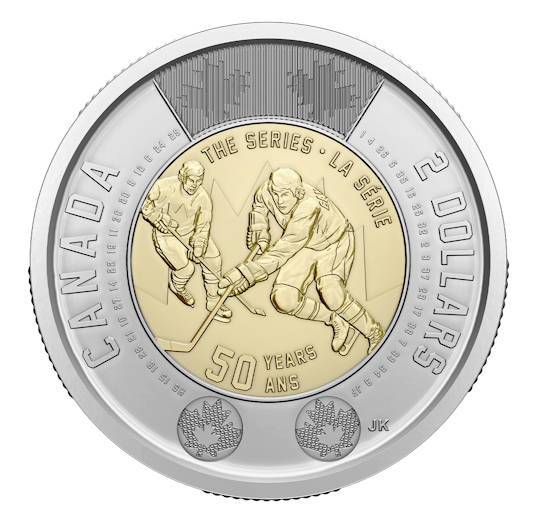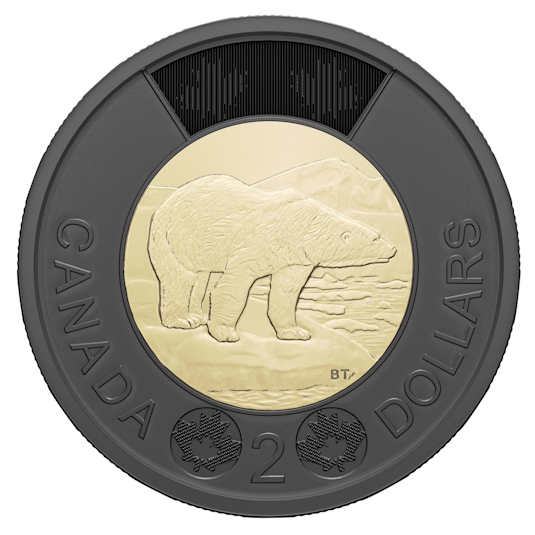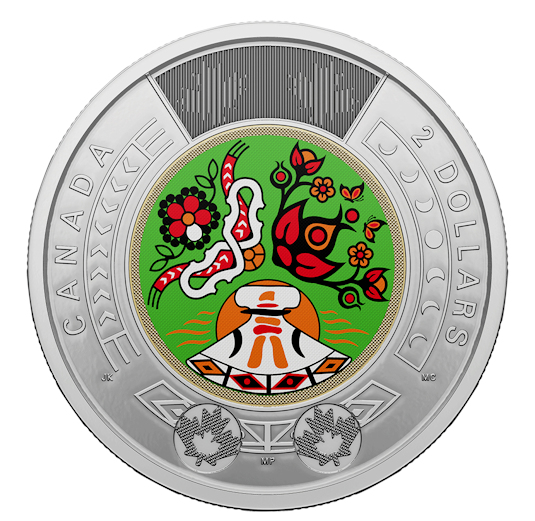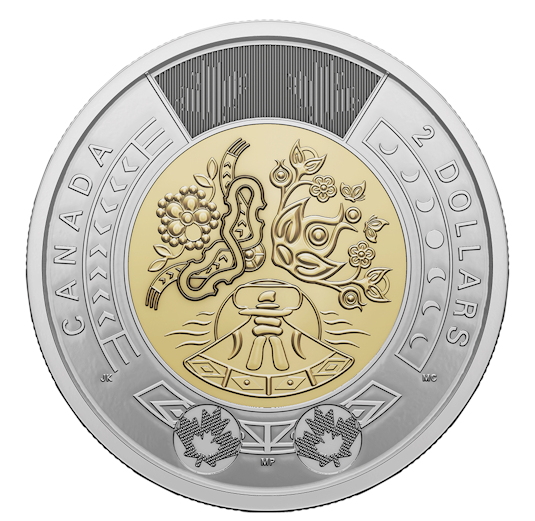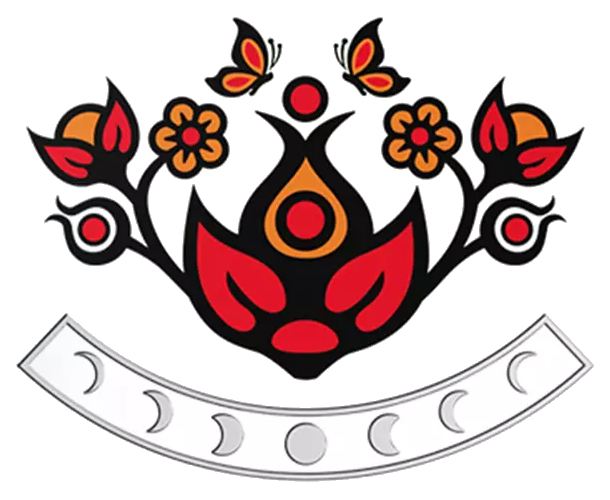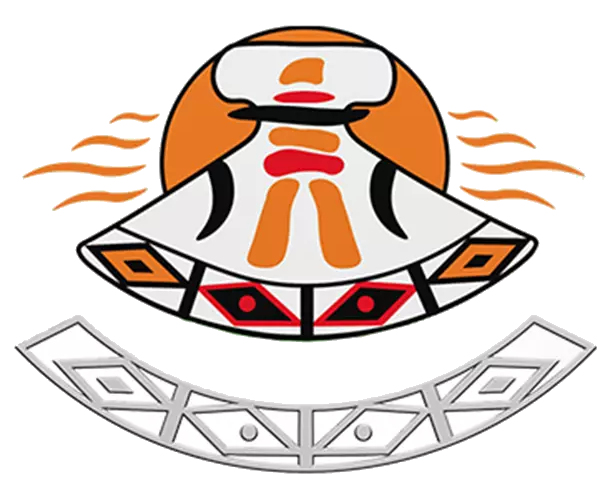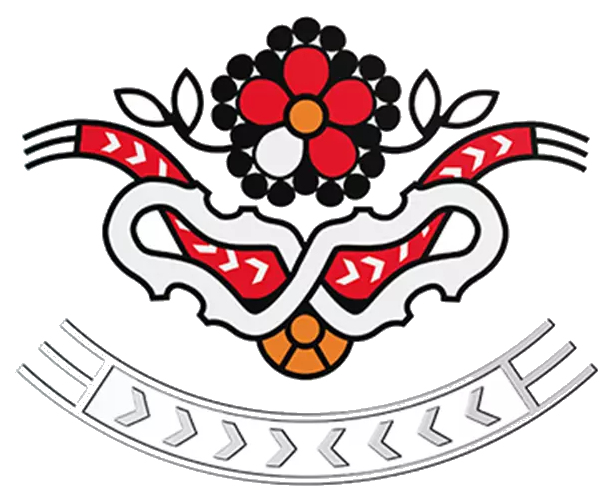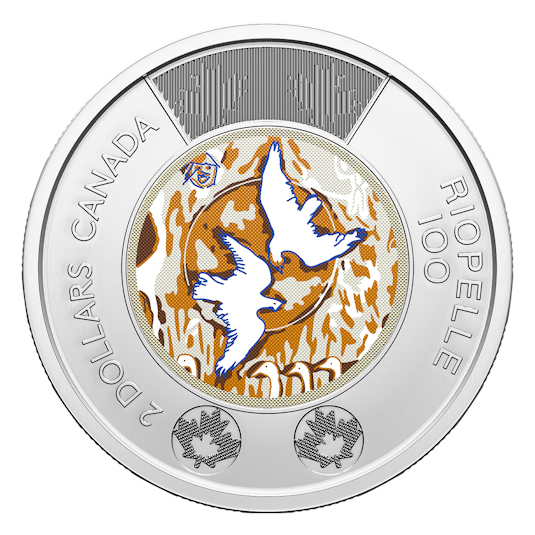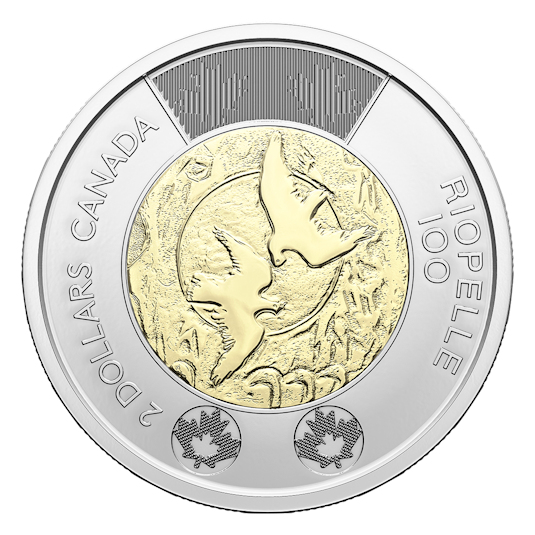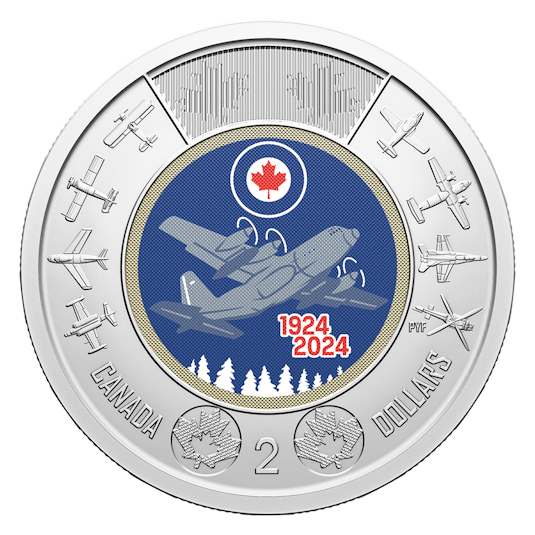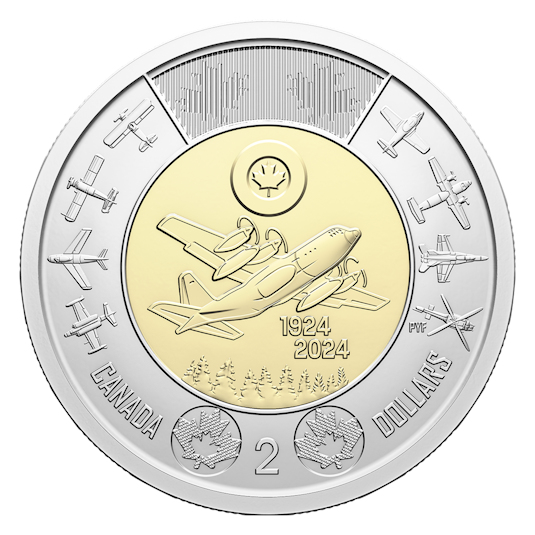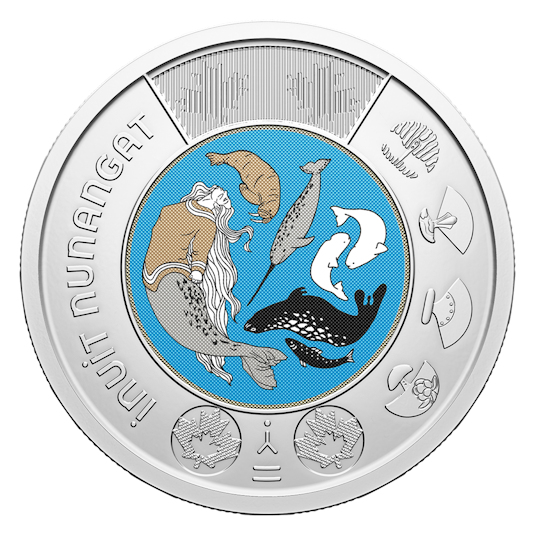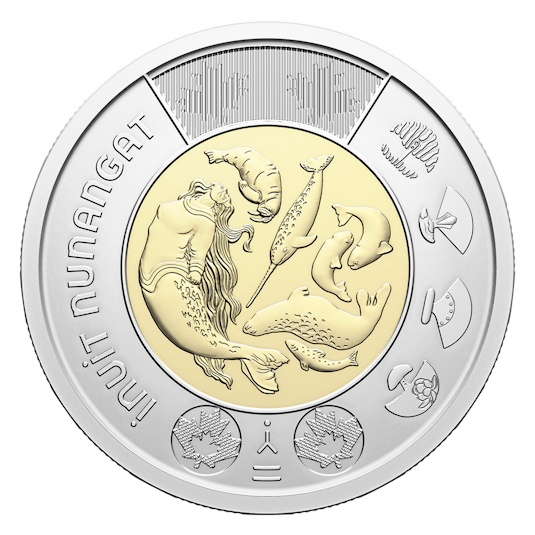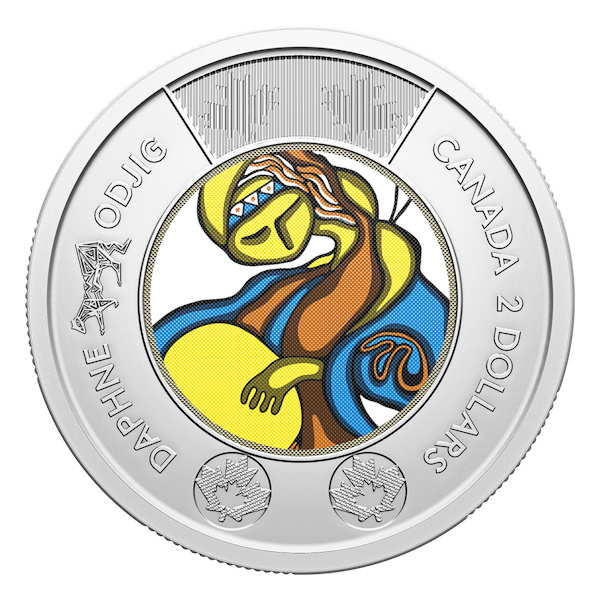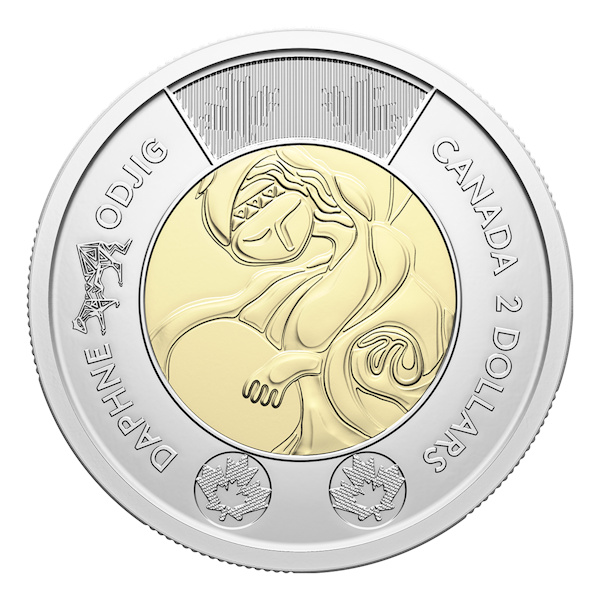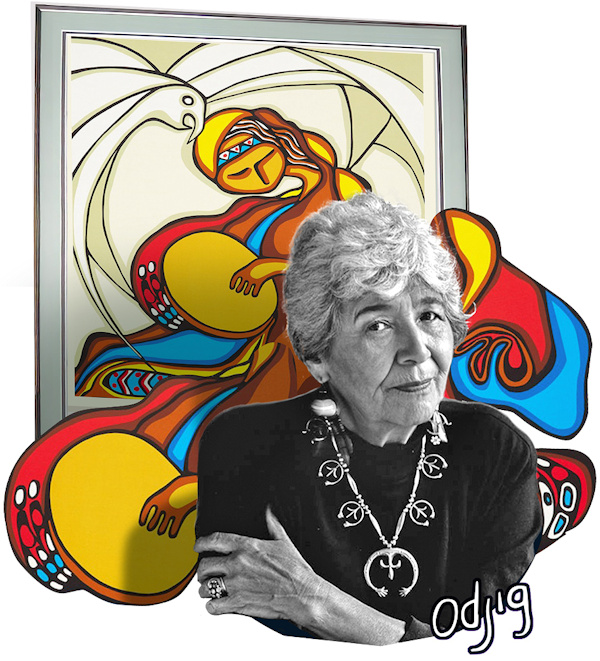Canadian Two Dollar Reverse Designs and Coin Specifications
Reverse Designs
|
This page shows the major die designs since Canadian two dollar coins were introduced in 1996. It does NOT cover "die blunders", where dies were re-punched
with different years (and the previous number is visible below the current number), or where cracks appeared in the dies causing unwanted lines
to appear in the coin. It also does not cover date doubling or special coins created for the collector market. All of the coin designs displayed here were
manufactured for general circulation as legal tender. The 2-dollar coin was first introduced on February 19, 1996, to replace the 2-dollar bill. The 'Toonie' has a life span approximately 20 times longer than paper currency and is manufactured using a distinctive bi-metallic coin locking mechanism patented by the Royal Canadian Mint NOTE: Click on any photo to load a much larger version of the same photo |
||||||||||||||||||||||||||||||
|
||||||||||||||||||||||||||||||
Designed by wildlife and landscape artist Brent Townsend and Ago Aarand, the 2-dollar coin, or 'Toonie', as Canadians have named it, features the image of an adult polar bear in early summer on an ice floe.
|
|||||||||||||||||||||||||||||||||||||||||||||||||||||||||||||||||||||||||||||||||||||||||||||||||||||||||||||||||||
1999 2 dollar circulation coin The Founding of Nunavut (1999) Nunavut First Nations artist Germaine Arnaktauyok and Jose Osio created a special design to commemorate the founding of Nunavut, Canada's newest territory. This design appeared on all 1999 two-dollar coins produced for general circulation. In 1999, the Polar Bear design appeared only in a limited number of special coin sets produced for the collector market. At some point (the beginning?) of the production, the dies designed for the silver and gold version of the this design were used to mint regular circulation coins. In the silver and gold version there is no raised ring between the outer and inner core of the coin. As a result, some uncirculated sets were produced with this "mule" coin |
|||||||||||||||||||||||||||||||||||||||||||||||||||||||||||||||||||||||||||||||||||||||||||||||||||||||||||||||||||
2000 Path of Knowledge 2 dollar circulation coin For the new millennium, artist Tony Bianco illustrated a female polar bear and her two cubs to represent the transfer of knowledge from one generation to the next. The inscription on the coin's outer rim reads "Knowledge - Le Savoir." This was the only "tails" design to appear on the 2000 two-dollar circulation coin. |
|||||||||||||||||||||||||||||||||||||||||||||||||||||||||||||||||||||||||||||||||||||||||||||||||||||||||||||||||||
2006 2 dollar circulation coin Two new coins for the 10th Anniversary of the two-dollar circulation coin (2006) In celebration of the 10th anniversary of its introduction, the two-dollar circulation coin was produced in two versions: - The first honouring the traditional Polar Bear design of artist Brent Townsend. What differentiates this issue from a standard $2 coin is that the obverse of this coin shows a double date of 1996-2006 below the Queen's effigy. - The second featuring a pose of the bear looking up at the dramatic lines of an Aurora Borealis, designed by Tony Bianco and Steve Witten. At some point in the process the bear in this design was nicknamed "Churchill" |
|||||||||||||||||||||||||||||||||||||||||||||||||||||||||||||||||||||||||||||||||||||||||||||||||||||||||||||||||||
2008 2 dollar circulation coin - 400th Anniversary of the founding of Quebec City Quebec artist Genevieve Bertrand won a design competition to create a new reverse of the two-dollar circulation coin commemorating the 400th anniversary of Quebec City. The date 1608 appeared on the left side of the outer ring, while 2008 appeared on the right of the ring on this commemorative coin's reverse side. Only six million of these special coins circulated, in addition to more than 17 million 2008 Toonies produced with the traditional Polar Bear design. As the date was moved to the reverse side of this commemorative coin, the Mint Mark was moved to the core of the coin on the obverse, to the immediate left of Her Majesty's effigy. |
|||||||||||||||||||||||||||||||||||||||||||||||||||||||||||||||||||||||||||||||||||||||||||||||||||||||||||||||||||
2011 Boreal Forest As part of it's Legendary Nature series, the Mint released a special 2 dollar coin honoring Canada's boreal forest. Designed by Nolin BBDO Montreal, the two-dollar circulation coin celebrating Canada's boreal forest coincides with the United Nations declaration of 2011 as the International Year of the Forest. The boreal forest is the world's largest ecosystem, which covers over half of Canada's landmass, from New Brunswick to the Northwest Territories and Yukon. As depicted through artistic interpretations of different tree species on the reverse of this circulation coin, the boreal forest landscape is defined by coniferous and hardy deciduous trees adapted to long winters and short growing seasons. |
|||||||||||||||||||||||||||||||||||||||||||||||||||||||||||||||||||||||||||||||||||||||||||||||||||||||||||||||||||
During the 2012 production year a radical design change was made to increase security and combat couterfeiting. While the new two-dollar coin maintains the traditional "Polar Bear" design, there are three visible changes: - The addition of two laser marks of maple leaves, each within a circle, at the bottom of the coin's reverse. - A virtual image of two maple leaves appear at the top of the coin - a different image is produced as the coin is turned from side to side. The virtual image is produced by engraving different patterns on each side of two-sided grooves on the face of the coin. - Edge-lettering of the words "CANADA" and "2 DOLLARS" are engraved along the coin's outer edge. The edge lettering which was introduced along with the new security features is stamped into each coin by a separate press, so there is no way to control which side faces up as each coin enters the press. As a result there are two varieties of each coin. - With the Type A edge the edge lettering is right side up when the obverse is showing: - With the Type B edge the edge lettering is right side up when the reverse is showing: |
|||||||||||||||||||||||||||||||||||||||||||||||||||||||||||||||||||||||||||||||||||||||||||||||||||||||||||||||||||
During 2012 a special circulation coin was designed by Bonnie Ross for the Mint's War of 1812 Bicentennial series. It depicts the HMS Shannon leaving the Halifax harbor during the War of 1812. Special features: - In an original design, the image covers the entire coin. - First commemorative coin to incorporate the Mint's new security features. - Includes Government of Canada's 1812 logo. - Depicts HMS Shannon's figurehead. |
|||||||||||||||||||||||||||||||||||||||||||||||||||||||||||||||||||||||||||||||||||||||||||||||||||||||||||||||||||
Wait For Me Daddy The reverse image is inspired by the iconic photograph named "Wait for me Daddy", which was taken on Oct 1, 1940 in New Westminster by photographer Claude Dettloff. The men of the B.C. Regiment, the Duke of Connaught's Own Rifles, formed an impressive line as they marched down the street. In the centre of the image, a pale young boy, Warren "Whitey" Bernard, has broken free of his mother's grasp to reach out to his uniformed father, who is marching off to war. 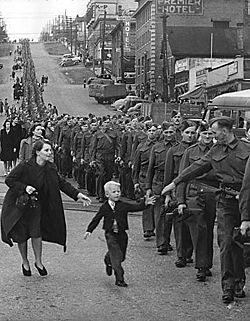 |
|||||||||||||||||||||||||||||||||||||||||||||||||||||||||||||||||||||||||||||||||||||||||||||||||||||||||||||||||||
Designed by Glen Loates, the "In Flanders Fields" 2 dollar coin depicts the 100th anniversary of Canadian John McRae's First World War poem, titled "In Flanders Fields". Design: In addition to the standard security features the reverse design depicts John McRae seated next to a war cemetary while writing his legendary poem while a number of birds fly overhead. This image is flanked by a group of poppies on each side. The bottom of the design includes the words "REMEMBER" and "SOUVENIR" flanking the year of issue. |
|||||||||||||||||||||||||||||||||||||||||||||||||||||||||||||||||||||||||||||||||||||||||||||||||||||||||||||||||||
Also released in 2015 was a 2 dollar coin honouring the 200th anniversary of the birth of Sir John A. MacDonald, Canada's first Prime Minister.
|
|||||||||||||||||||||||||||||||||||||||||||||||||||||||||||||||||||||||||||||||||||||||||||||||||||||||||||||||||||
Released in 2016, this 2 dollar coin commemorates the efforts of the Royal Canadian Navy, the Merchant Marine and the RCAF in transporting
troops and supplies to the war in Europe, and those ships and aircraft who defended the Atlantic ocean against the German Wolfpack of submarines. Design: A watchful sailor presses his eye to the viewfinder of his anti-aircraft gun, scanning the skies for threats while unforgiving seas roll by below. The central image of the coin design - a sailor aboard a Canadian warship - is accompanied by the depiction of two other Canadian vessels in the distance while a Bristol Beaufighter flies overhead. |
|||||||||||||||||||||||||||||||||||||||||||||||||||||||||||||||||||||||||||||||||||||||||||||||||||||||||||||||||||
While the standard Polar design was used for the classic 2 dollar coin (only produced for the "Classic Canadian Coin Set"), a special series of circulation coins
were produced to commemorate the 150th anniversary of Confederation. The Sesquicentennial 2 dollar coin - "Dance of the Spirits" To commemorate the 150th anniversary of Confederation, a design contest was held among all ordinary citizens. The two dollar coin was designed by Timothy Hsia from Richmond, British Columbia . This unique design depicts paddlers gliding across a placid lake under the shimmering curtain of the Northern Lights - which the Cree peoples called "the dance of the spirits". A second coin was released using the same design, but with colour added to the main reverse design elements. The coloured part of the design which depicts the Northern Lights also has an element which glows in the dark - It is a World first that a glow in the dark circulation coin has been produced. |
|||||||||||||||||||||||||||||||||||||||||||||||||||||||||||||||||||||||||||||||||||||||||||||||||||||||||||||||||||
Late in 2017 the Royal Canadian Mint released a second commemorative two dollar coin. This one commemorates the 100th Anniversary of the Battle of Vimy Ridge. In the spring of 1917, the Allies launched a new offensive on the Western Front, where all four divisions of the Canadian Corps were ordered to capture the heavily fortified Vimy Ridge. For the first time ever, divisions from all across Canada fought side-by-side at the same time to secure victory. This special two-dollar coin honours the Canadians at Vimy, where their valour and sacrifice contributed to a defining moment for our young nation and its military. Design: Designed by Canadian artist Tony Bianco, the coin design features the Canadian National Vimy Memorial in Vimy, France flanked by a First World War soldier on the left and a veteran soldier on the right. |
|||||||||||||||||||||||||||||||||||||||||||||||||||||||||||||||||||||||||||||||||||||||||||||||||||||||||||||||||||
In September of 2018 the Royal Canadian Mint released a pair of commemorative two dollar coins. They commemorate the 100th Anniversary of the end of the First World War (Armistice Day). With two minutes of silence each November 11, Canadians commemorate four years that changed the course of history. It is at the exact moment of Armistice, when the first modern war suddenly came to an end in 1918, that we silently reflect upon that conflict of unprecedented scale, and all who served in a war that was supposed to "end all wars." Design: Designed by Canadian artist Laurie McGaw, the reverse designs mark the 100th anniversary of the Armistice of 1918 with a poignant pairing of two symbols of remembrance. Within the brass-plated inner core, a soldier's helmet represents the end of the First World War and serves as a solemn reminder of the many lives lost during history's first mechanized war. Below the helmet lies a large poppy, the official bloom of remembrance. - In the first version of this coin the poppy's bright scarlet colour is re-created. Two more poppies are engraved on the nickel-plated outer ring, which includes a special-engraved security feature, along with a banner bearing the bilingual words "REMEMBER", "SOUVENIR" and the year "2018". - The second version of this coin is identical to the coloured one with the exception of the main poppy. Instead of being coloured, the poppy's details have been engraved. |
|||||||||||||||||||||||||||||||||||||||||||||||||||||||||||||||||||||||||||||||||||||||||||||||||||||||||||||||||||
In June of 2019 the Royal Canadian Mint released a pair of commemorative two dollar coins. They commemorate the 75th Anniversary of the D-Day invasion of Normandy, France. What thoughts go through a soldier's mind in the moments before battle? This riveting coin takes you aboard a landing craft where Canadian soldiers are peering over the ramp as they approach the coast of Normandy (France) on D-Day. Their mission: to establish a beachhead at Juno Beach. For months prior, Allied aircraft bombed German installations along the heavily defended coast in preparation for the arrival of a massive invasion force - 150,000 Allied troops that came ashore on June 6, 1944. Among them, 14,000 Canadians who secured their beachhead (Juno) before moving to capture German positions further inland. On D-Day alone, 359 Canadians lost their lives, and by the time Paris was liberated on August 25th, more than 5,000 Canadians had made the ultimate sacrifice to regain critical ground for the Allies in Western Europe. Design: This coin designed by Canadian artist Alan Daniel is charged with tense anticipation as Canadian soldiers peer from their landing craft en route to Juno Beach. This compelling landing craft perspective extends beyond the inner core to the outer ring where naval and air forces support the Allied landings. - In the first version of this coin the soldier's helmet is shown in full colour while the "D-DAY/LE JOUR J" text above the helmet is printed in a vibrant red colour. - In the second version of this coin the soldier's helmet as well as the "D-DAY/LE JOUR J" text above the helmet are engraved, while the rest of the coin is identical to the coloured version. |
|||||||||||||||||||||||||||||||||||||||||||||||||||||||||||||||||||||||||||||||||||||||||||||||||||||||||||||||||||
In July of 2020 the Royal Canadian Mint released a pair of commemorative two dollar coins. They celebrate the 100th Anniversary of the birth of world famous Haida artist and sculptor Iljuwas (Bill Reid) (1920-1998).
These commemorative circulation coins are a celebration of the Haida artist's legacy and of Haida culture. You can read all about this legendary artist by visiting the web site of the Vancouver gallery which is dedicated to his story and works. Click here to visit the Bill Reid Gallery Design: The reverse design features Xhuwaji, Haida Grizzly Bear by renowned Haida artist Iljuwas (Bill Reid) on the inner core and extending onto the outer ring. The bear is encircled by a ring and enhanced by colours of red, white and black. On the top portion of the outer ring, two images of a maple leaf appear within the line pattern. A banner at the bottom of the outer ring bears the inscriptions "BILL" and "REID" in honour of the 100th anniversary of the Haida artist's birth, while "2020" is centred between two security marks that consist of a maple leaf within another maple leaf. A second design contains all of the features in the coloured version, but none of the details are in colour. NOTE: Mr. Reid's work titled "The Spirit of Haida Gwaii" was immortalized on the 2004 issue of the Canadian $20 note as shown here: 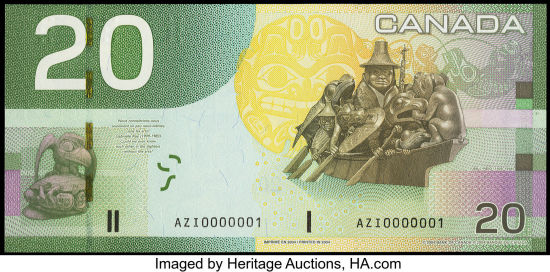
|
|||||||||||||||||||||||||||||||||||||||||||||||||||||||||||||||||||||||||||||||||||||||||||||||||||||||||||||||||||
In September of 2020 the Royal Canadian Mint released a pair of commemorative two dollar coins. They celebrate the 75th Anniversary of the End of the Second World War
The Victory nickel was introduced in 1943 to provide inspiration and solidarity to the Canadian people while the Second World War raged on in Europe and the Pacific. Thomas Shingles created the "Victory" design to promote the war effort. The normal denticles were replaced in this design with the phrase "We Win When We Work Willingly", translated into Morse Code. This design served as the inspiration for these two dollar coins. Design: Enhanced with selective colour, the reverse pays tribute to the Victory 5-cent coin designed by Thomas Shingles ("T.S."). On the inner core, a blue "V" for Victory is overlaid with a torch topped by orange and yellow flames. The Canadian victory emblem is flanked by maple leaves, while the double dates "1945" and "2020" commemorate the 75th anniversary of the end of the Second World War. At the top of the outer ring, two images of a maple leaf appear within the line pattern. The words "VICTORY" and "VICTOIRE" are framed by an inscription in International (Morse) Code; when translated, the dots and dashes mean "WE WIN WHEN WE WORK WILLINGLY" and "LA BONNE VOLONTE EST GAGE DE VICTOIRE". At the bottom of the outer ring, the inscriptions "REMEMBER" and "SOUVENIR" are paired with two security marks consisting of a maple leaf within another maple leaf. A second design contains all of the features in the coloured version, but none of the details are in colour. |
|||||||||||||||||||||||||||||||||||||||||||||||||||||||||||||||||||||||||||||||||||||||||||||||||||||||||||||||||||
In 2021 the Royal Canadian Mint released a pair of commemorative two dollar coins. They celebrate the 100th Anniversary of the discovery of insulin.
One of Canada's greatest contributions to medical research was the discovery of insulin in 1921 by Sir Frederick G Banting, Charles H Best and JJR Macleod at the University of Toronto in 1921. It was subsequently purified by James B Collip. Before 1921, it was exceptional for people with type 1 diabetes to live more than a year or two. Design: Designed by Canadian artist Jesse Koreck, the $2 coin's reverse is double dated ("1921 2021") to commemorate the 100th anniversary of the Canadian medical innovation. The discovery of insulin at a University of Toronto laboratory is represented by a maple leaf and traditional symbols: an early insulin vial, an Erlenmeyer flask, a mortar and pestle. The inner core shows insulin in monomeric form, which is highlighted in blue on the coloured coins, while the depiction of the hormone at work in the bloodstream extends onto the outer ring. The obverse features the effigy of Her Majesty Queen Elizabeth II by Susanna Blunt. A second design contains all of the features in the coloured version, but none of the details are in colour. |
|||||||||||||||||||||||||||||||||||||||||||||||||||||||||||||||||||||||||||||||||||||||||||||||||||||||||||||||||||
In October of 2022 the Royal Canadian Mint released a pair of commemorative two dollar coins. They celebrate the 50th Anniversary of the 1972 Canada-USSR hockey Summit Series.
Celebrate the 50th anniversary of the historic hockey series that captivated this nation, igniting passions and uniting Canadians around their national team. The 1972 Summit Series was a defining moment for Canadians, and the 2022 $2 commemorative circulation coins proudly honour Canada's Summit Series team. Design: The reverse design by Canadian artist Joel Kimmel features two hockey players representing Team Canada in the 1972 Canada-U.S.S.R. Summit Series. Set against the team jersey's iconic maple leaf, which is highlighted in red on the colourized coin, the hockey players are accompanied by the words "THE SERIES LA SERIE" and "50 YEARS ANS". On the outer ring, the coaches' initials and the players' jersey numbers surround the inner core to represent the spirit of Team Canada. The obverse features the effigy of Her Majesty Queen Elizabeth II by Susanna Blunt. For the first time the core of the coloured coin has no relief at all. The entire core design is blank, allowing for the full core to be coloured. A second design contains all of the features in the coloured version, but none of the details are in colour. Team Canada roster for the 1972 Summit Series Head Coach and General Manager (GM): Harry Sinden ("HS" initials on the reverse) Assistant Coach/GM: John Ferguson ("JF" initials on the reverse)
|
|||||||||||||||||||||||||||||||||||||||||||||||||||||||||||||||||||||||||||||||||||||||||||||||||||||||||||||||||||
In December of 2022 the Royal Canadian Mint released a special commemorative two dollar coin which serves as a solemn tribute to the reign of Queen Elizabeth II (1926-2022). Designed to emulate a mourning arm band, the black outer ring surrounds the default polar bear design at the centre of the coin's reverse. She was a constant presence in the lives of Canadians, who will forever remember her unwavering dedication to public service and deep affection for Canada and our people. Design: Designed by wildlife and landscape artist Brent Townsend and Ago Aarand, the default $2 reverse design features the image of an adult polar bear in early summer on an ice floe. The outer ring is made of black tinted nickel plated steel. |
|||||||||||||||||||||||||||||||||||||||||||||||||||||||||||||||||||||||||||||||||||||||||||||||||||||||||||||||||||
In June of 2023 the Royal Canadian Mint released a special commemorative two dollar coin which celebrates the heritages,
diverse cultures and outstanding achievements of First Nations, Inuit and Metis peoples in Canada, which is observed every year as "National Indigenous Peoples Day" on June 21.
Design: The 2023 commemorative $2 circulation coin combines the art of the following artists, whose joint creation stunningly combines their expressions of First Nations, Inuit, and Metis cultures, art and traditions and is an open invitation to celebrate National Indigenous Peoples Day:
The obverse features the effigy of Queen Elizabeth II by Susanna Blunt. The obverse also bears a special marking that includes four pearls symbolizing the four effigies that have graced Canadian coins and the double date of her reign. |
|||||||||||||||||||||||||||||||||||||||||||||||||||||||||||||||||||||||||||||||||||||||||||||||||||||||||||||||||||
In October of 2023 the Royal Canadian Mint released a pair of commemorative two dollar coins. They commemorate the 100th Anniversary of the birth of artist Jean Paul Riopelle.
Montreal-born Jean Paul Riopelle (1923-2002) was one of the most globally revered Canadian artists of the 20th century. He left a legacy defined by his distinct artistic vision. Throughout his 50-plus-year career, Riopelle produced nearly 7,000 pieces of art and was featured in over 200 exhibits across the globe. With works that reveal a lifelong love of nature, and mosaics that reflect his belief in unconstrained creative expression, Riopelle used his art to push boundaries and command the attention of critics and art lovers worldwide. His unique perspective and inimitable style established Riopelle as one of the most renowned and recognized artists of the 20th century, and influenced Canadian art for generations to come. Design: Enhanced with selective colour, the inner core adapts select elements of Panel 29 of L'Hommage a Rosa Luxemburg by Jean Paul Riopelle, while the outer ring bears the "Riopelle100" centenary mark (courtesy of the Riopelle Foundation). The obverse features the effigy of Queen Elizabeth II by Susanna Blunt. The obverse also bears a special marking that includes four pearls symbolizing the four effigies that have graced Canadian coins and the double date of her reign. A second design contains all of the features in the coloured version, but none of the details are in colour. NOTE: - The 'Riopelle100' mark, created by Raphael Melancon, appears on the coin courtesy of the Riopelle Foundation, in collaboration with which the coin was created. - Panel 29 of L'Hommage a Rosa Luxemburg, 1992, acrylic and spray paint on canvas. Triptych, 1.55 m in height x 40.39 m in length. Copyright Estate of Jean Paul Riopelle / Copyright Visual Arts - CARCC (2023). |
|||||||||||||||||||||||||||||||||||||||||||||||||||||||||||||||||||||||||||||||||||||||||||||||||||||||||||||||||||
In September of 2024 the Royal Canadian Mint released a pair of commemorative two dollar coins. They commemorate the 100th Anniversary of the formation of the Royal Canadian Air Force.
Design: Designed by Toronto-based illustrator Pui Yan Fong, the coin's reverse spans 100 years of Royal Canadian Air Force (RCAF) history, represented by stylized depictions of aircraft flown by RCAF personnel past and present. The inner core features the RCAF roundel above a Model H of the CC-130 Hercules that has been the mainstay of the RCAF transport fleet for over 60 years; the upward angle of the Hercules is a nod to the RCAF motto, Sic itur ad astra ("Such is the pathway to the stars"), while the double dates "1924 2024" commemorate the RCAF Centennial. Eight current and historical RCAF aircraft appear on the outer ring, from top to bottom: the Finch Mk. II, CSR-123 Otter, F-86 Sabre Mk. 6 and CF-100 Canuck Mk. 5 on the left side; and on the right, the CT-114 Tutor, CC-115 Buffalo, CF-188 Hornet and CH-146 Griffon helicopter. The obverse features the effigy of His Majesty King Charles III by Canadian artist Steven Rosati. A second design contains all of the features in the coloured version, but none of the details are in colour. |
|||||||||||||||||||||||||||||||||||||||||||||||||||||||||||||||||||||||||||||||||||||||||||||||||||||||||||||||||||
In November of 2024 the Royal Canadian Mint released a pair of commemorative two dollar coins. They celebrate the Inuit homeland in Canada.
Design: These 2024 commemorative $2 coins combine the art of four Inuit artists representing each of the four treaty areas of Inuit Nunangat: - Tegan Voisey (Makkovik, Nunatsiavut), - Thomassie Mangiok (Ivujivik, Nunavik), - Charlotte Karetak (Arviat, Nunavut) and - Mary Okheena (Ulukhaktok, Inuvialuit Settlement Region). A unifying symbol on the inner core, Nuliajuk the spirit of the sea is an ancient story shared, with regional variations, by Inuit communities across Inuit Nunangat; she is connected to Inuit through her bond with the sea creatures that Inuit depend on for food and resources, represented by a walrus, narwhal, two beluga whales, a seal and Arctic char. On the outer ring, each of the four artists has designed a regionally specific ulu. A pattern used both in the tradition of Inuit tattooing and on clothing appears between the two security features at the base of the ring, while the inclusion of "INUIT NUNANGAT" expresses the importance of this terminology in the expression of Canada's identity. The obverse features the effigy of His Majesty King Charles III by Canadian artist Steven Rosati. A second design contains all of the features in the coloured version, but none of the details are in colour. |
|||||||||||||||||||||||||||||||||||||||||||||||||||||||||||||||||||||||||||||||||||||||||||||||||||||||||||||||||||
In September of 2025 the Royal Canadian Mint released a pair of commemorative two dollar coins. They celebrate the Life and Art of Daphne Odjig.
Daphne Odjig (1919-2016) was not only one of the most celebrated artists active in Canada in the 20th century, but a pathbreaking advocate for Indigenous art and culture. Her immense portfolio includes everything from minimalist fine-line sketches to massive paintings blazed with bold colour. She is the recipient of some of Canada's highest honours, and the first First Nations woman artist to be represented on a Canadian circulation coin. These 2025 commemorative $2 coins pay tribute to Odjig's legacy as a creative force for change. Design: Core: Based on Odjig's Folk Singer, the $2 coin's core design serves as an inspiring representation of the bold linework that characterized much of the artist's work. Outer Ring: The outer ring design includes Odjig's drawing of a fisher, as it appears above her signature on her 1978 masterpiece The Indian in Transition, where it serves as a visual representation of her surname (the anglicized version of "Odjig" is "Fisher"). The obverse features the effigy of His Majesty King Charles III by Canadian artist Steven Rosati. A second design contains all of the features in the coloured version, but none of the details are in colour. |
|||||||||||||||||||||||||||||||||||||||||||||||||||||||||||||||||||||||||||||||||||||||||||||||||||||||||||||||||||

